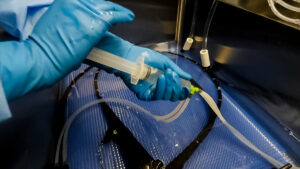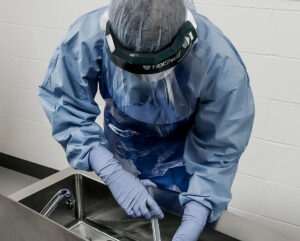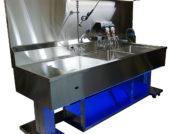
Making a Case for Automated Endoscope Flushing: The Data Behind the Guidelines
Endoscopes are critical medical instruments used for various procedures such as colonoscopy, gastroscopy, bronchoscopy, among others. Due to the complexity of the device and the nature of the procedures they are used for, endoscopes are prone to contamination with bacteria and other pathogens. Therefore, it is essential to clean and disinfect endoscopes thoroughly before they can be used on another patient to prevent avoidable infections.
AORN, SGNA, ANSI/AAMI, among others, have issued guidelines for the reprocessing of endoscopes, including pre-cleaning, leak testing, manual cleaning, high-level disinfection, and storage. In this post, we review the data behind automated flushing endoscopes during the manual cleaning step, and how studies within make a compelling case for automated flushing technologies.
Reduction of Human Error Rate
Human error is common in all jobs, including the reprocessing of endoscopes. Reprocessing endoscopes involves many steps, and those who perform this task have limited space, time, and resources. As a result, some steps may be overlooked.
A study revealed that nurses and technicians frequently do not follow all reprocessing steps for endoscopes. The study found that over 47% of personnel did not consider manual cleaning to be a step they enjoyed in the manual cleaning process. Additionally, 98.6% of personnel did not perform all 12 required steps of endoscope reprocessing IFU correctly.1 These findings suggest that failure to adhere to recommended protocols is the primary cause of endoscopy-related infections.
To ensure compliance and reduce human error, the use of automated flushing instead of manual flushing is recommended. Automated flushing can reduce the time spent manually cleaning by nurses and technicians while removing steps which can be subject to interpretation or accidental oversight.
Increasing Efficiency
In the same Ofstead & Associates study, 75% of employees reported feeling pressure to work quickly when reprocessing endoscopes.1 This  comes to no surprise, due to high turnover of both staff and scopes. With manual cleaning consuming a large chunk of time, use of automated flushing systems during the manual cleaning stage of endoscope reprocessing can result in more efficient and effective results compared to manual flushing. The devices built for automated flushing are designed to provide consistent flow and pressure during flushing. When two facilities used the Flush Buddy Systems, they found and increase in efficiency and consistent flush times.1
comes to no surprise, due to high turnover of both staff and scopes. With manual cleaning consuming a large chunk of time, use of automated flushing systems during the manual cleaning stage of endoscope reprocessing can result in more efficient and effective results compared to manual flushing. The devices built for automated flushing are designed to provide consistent flow and pressure during flushing. When two facilities used the Flush Buddy Systems, they found and increase in efficiency and consistent flush times.1
Ergonomic Benefits
Using automatic flushing during the manual cleaning stage of endoscope reprocessing can provide several ergonomic benefits over manual  flushing with a syringe. According to Sivek, “There also are manual flushing aids available for staff who perform manual cleaning. Doing that flushing manually is quite onerous—think about flushing a scope with a syringe over and over. It can result in issues with the wrist, hand and thumb, especially for anyone who has arthritis.”
flushing with a syringe. According to Sivek, “There also are manual flushing aids available for staff who perform manual cleaning. Doing that flushing manually is quite onerous—think about flushing a scope with a syringe over and over. It can result in issues with the wrist, hand and thumb, especially for anyone who has arthritis.”
Further reinforcing this statement, one baseline survey revealed that correlation between employee physical pain and number of hours reprocessing each week (p= .041), with 47% of survey participants stating that the discomfort in their hands or arms.1 If automated flushing was included in manual cleaning, the percentage of employees experiencing hands or arm pains could be reduced.
Conclusion
Manual cleaning of endoscopes is a critical step in the reprocessing process that requires attention to detail to ensure that the endoscopes are thoroughly cleaned and disinfected before use on another patient. With advances over the years and the launch of diversified flushing pump options, automated flushing is now an effective and efficient way to flush endoscopes beyond syringes, reducing the risk of human error, saving time, and improving effectiveness. As such, their use should be considered as an alternative to manual flushing channels in accordance with IFU, ANSI/AAMI, SGNA, AORN guidelines, among other recommending associations.
Learn more about the FlexiPump’s benefits in increasing efficiency, staff ergonomics, and reducing human error compared to manual flushing and competition.
Curious about the best practices when flushing practices for reprocessing flexible and rigid endoscopes? Read more here!
Citations:
Ofstead, C. L., Wetzler, H. P., Snyder, A. K., & Horton, R. A. (2010). Endoscope reprocessing methods: a prospective study on the impact of human factors and automation. Gastroenterology Nursing, 33(4), 304-311. [IIIA]




